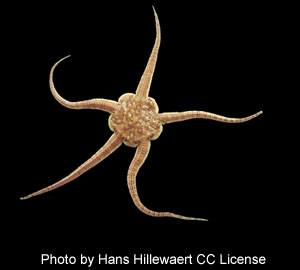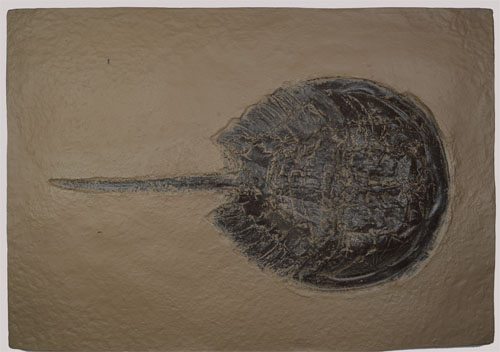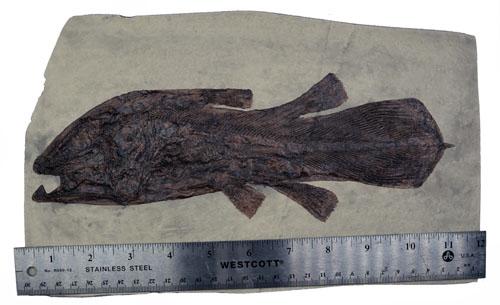Museum Exhibits: Fulfilling Predictions
What Does Evolution Predict?
One type of life form slowing evolved, changing to become a different type of life form. This process took place, slow step by slow step, with natural selection preserving those changes that were beneficial. So... what should we see in the fossil record? Many fossils, selected to survive by natural selection, showing the transitions from one type of organism to another. What do we see? Less than a handful of disputed, supposed transitional fossils. The evidence we should see is not there.
What Does Biblical Creation Predict?
That we will see stasis in the fossil record, meaning no change. Some organisms in the lowest sediment layers will still be in existence today with little change, while other organisms have gone extinct and are not seen today.
What do we see? Thousands of living things that are found in lower levels of sediment still exist today with little change. Our museum has some examples:
The Brittle Star

This is an actual fossil brittle star in our museum.
The photo below shows a present day brittle star (Ophiura ophiura). As you can see, they are the same. No change. No evolution.

An interesting fact about brittle stars is that do not appear to have eyes. However, it turns out the entire brittle star functions as a giant, compound eye. However, what is more amazing is that the brittle star accomplishes this by secreting tiny calcite crystals that form an array of double-lensed micro-lenses. These lens are part of the skelton and they focus light onto nerves in the tissues of the brittle star. This complex system requires controlling the growth of the calcite crystals and even controlling the orientation of the crystals. Natural crystals cannot be used as lenses. This amazing and complex eye could not have evolved by natural selection acting on small changes. The perfect crystals, their orientation, the structures to hold them in place, the arrangement such that the focus the light, the nerves to detect the light, and the ability take what nerces detect and interpret as something visual must all be in place and fully functional. Otherwise there is nothing for natural selection to select.
The brittle star is an example of God's amazing design, as well as showing us no change from fossils to present-day brittle stars. (Reference: Creation.com Brittle Star Article)
Horseshoe Crabs

This is a casting of a fossil horseshoe crab we have in our museum. Fossil horseshoe crabs look exactly like horseshoe crabs today. Hundreds of millions of years have supposedly gone by and... no change. The oldest horseshoe crab fossils are evolutionary dated to 445 million years old. And there has been no evolutionary change. Or... what fits the evidence better is that they are just 4,500 years old. Dating to the time of Noah's flood when massive amounts of sediment buried billions of marine creatures... including horseshoe crabs.
The Coelacanth

The problem paleontology has is that no one was there to see the animals currently only represented by fossils. Since the late 19th century, based on fossil skeletons, it was taught that the coelacanth was the ancestor of land creatures... a transition between fish and amphibians. The first walking fish! They supposedly went extinct hundreds of millions of years ago... until one was caught in the Western Indian Ocean in 1938.
This is a photo of cast coelacanth replica you will see in our museum. The coelacanth is a lobed fin fish, meaning their fins are joined to their body by a single bone. It was though this was a development that allowed them to walk on the sea bottom, an intermediate step leading to walking on land. However, now that real coelacanths can be studied, we can see these fins are never used for "walking" of any sort. What was once thought to be a transitional fossil was debunked when a real, living coelacanth could be observed.
Crocodile

This is our small crocodile (Crocodilaemus robustus). If he could be straightened out it would be about 21 inches in length. It is from the Cerin Lagerstatte of eastern France and is evolution dated to be from the Kimmeridgain age (152 to 157 million years ago).
This fossil is identified as an extinct genus of a pholidosaurid mesoeucrocodylian crocodile. It illustrates something very common. In his book "Living Fossils" Dr. Carl Werner explains on observation resulting from a ten year experiment photographing fossils:
My experiment predicted I would find modern plant and animal species in dinosaur rock layers if evolution was not valid. While Debbie and I photographed many modern-appearing plants and animals found in dinosaur rock layers, not one fossil was assigned a modern species name." (page 28)
What Dr. Werner observed in thousands of fossils can be seen in this fossil crocodile. It looks exactly like living crocodiles we see today, yet it is identified as being extinct. The facts are that it is not extinct, however, evolutionary belief requires that living things change. That's how evolution works. So, based on the assumption evolution is true, fossils that look exactly like living animals (and plants) are given different names. It's obvious, after tens of millions of years they have to be different. No. The right way to do science is, if they look the same, classify them as being the same. Then follow the evidence wherever it leads... such as to a global flood about 4,500 years ago.
Predictions: The Results
Evolution should result in an abundance of transitional fossils. There are none. Only a handful of disputed fossils. Instead there is an abundance of fossils that show no change between the fossil and living plants and animals, exactly what is expected based on the Bible.
Continue the Tour